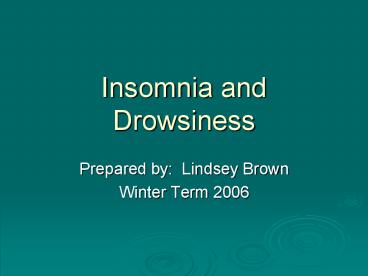Insomnia and Drowsiness - PowerPoint PPT Presentation
1 / 32
Title:
Insomnia and Drowsiness
Description:
of US population experienced insomnia in the past year. 30% of patients ... Endogenous hormone produced by pineal gland. Shifts circadian rhythm, body temp, and ... – PowerPoint PPT presentation
Number of Views:138
Avg rating:3.0/5.0
Title: Insomnia and Drowsiness
1
Insomnia and Drowsiness
- Prepared by Lindsey Brown
- Winter Term 2006
2
A disorder not a disease
- Diverse etiologies patient complaints
- Very subjective
- ½ of US population experienced insomnia in the
past year - 30 of patients have symptoms nightly
3
Questions?
4
Chief complaint?
- Specific complaint of insomnia?
- How is it affecting their daily activities?
5
Duration and Frequency?
- Transient lt 1 week
- Short term 1-3 weeks
- Chronic gt 3 weeks
6
Medical History?
- Current Medical Problem or Conditions?
- Current Medications (Rx or OTC)?
- Allergies or Sensitivities?
7
Good Sleep Hygiene
8
- Regular sleep pattern
- Comfortable surroundings
- Relax
- Exercise
- Break the cycle of daytime naps
- Avoid overeating close to bedtime
- Monitor caffeine and nicotine use
- Alcohol not a good sedative
- Avoid sleep anxiety
9
Diphenhydramine
- The only FDA approved OTC sleep aid
- Patient specific dosing (25-50mg QHS)
- Duration of sedation 3 - 6 hours
- Next morning hang-over tolerance are common
10
What to be aware of
- Anticholinergic SEs
- Contraindications BPH, difficulty urinating
- narrow closed angle glaucoma, CVD, dementia
- Do not use more than 7-10 days
11
Melatonin
- Endogenous hormone produced by pineal gland
- Shifts circadian rhythm, body temp, and
- alertness
- 0.3- 1 mg taken 1-2 hours prior to bedtime
12
Drowsiness Case Study
- 23 yo male comes to your pharmacy and states
that he was up all weekend studying for finals,
and is worried he cant stay alert to take the
tests he studied so hard for. He is looking for
an OTC stimulant to help stay awake for his 3
days of exams.
13
What do you need to know?
14
- Medical or psychiatric problems
- Current medications
- Caffeine consumption
- Sleep patterns
- Lifestyle
15
Caffeine
- Not a substitute for good sleep patterns
- Most frequently used stimulant in the world
- Good sleep hygiene, lifestyle modifications, and
referral should come 1st
16
If Caffeine is used
- Xanthine derivative that antagonizes the
receptors of Adenosine - Tolerance and withdrawal are common
- Usual Dose 100 -200mg Q3-4H PRN, NTE 600mg/day
- Special considerations
17
Ginseng
- Herbal product that inhibits thromboxane
- Weak antiplatelet effects, increased risk of
bleeding - May exacerbate psychiatric symptoms
- Hypoglycemic effects
- Usual Dose 100-300mg BID
18
Musculoskeletal Injuries
- Sprains, Strains and Pains
19
Musculoskeletal and connective tissue injuries
are the 3rd and 5th leading cause of lost work
days in men women in the US, respectively..
20
Patient Assessment
- There are no wrong answers
21
P,Q,R,S,T
- Precipitating factors
- Quality of pain
- Region or location
- Severity (changes in daily activities)
- Timing
22
Exclusions for self-treatment
- Pain with N/V
- Weakness in any limb
- Visually deformed joint or abnormal joint
movement - Joint pain with systemic symptoms
- Pelvic or abdominal pain
- Pain that is increasing or changing
- Flouroquinolone use
- Duration gt2 weeks
23
Tendonitis, Bursitis, Strains, and Sprains
- P protect
- R rest
- I ice (10-30 min TID-QID or at max Q2H)
- C compress
- E elevate
- NSAIDS
- 2 theories early vs. withhold
24
Counterirritants
- Paradoxical pain-relieving effect achieved by
producing a less severe pain to counter a more
intense one - Psychological component placebo effect
25
Rubefacients
- MOA vasodilation producing reactive hyperemia
redness - Methyl salicylate most widely used
26
Cooling Sensation
- Dose Dependent MOA
- Stimulates nerves that perceive cold while
depressing nerves that perceive pain, this is
followed by a sensation of warmth - Menthol
- Camphor
27
Vasodilation
- MOA
- Marked power of diffusion which leads to elevated
skin temperature at very low concentrations - Mediated by PG biosynthesis
- SEs drop in BP, pulse, and syncope
- Methyl Nicotinate
28
Incite Irritation
- MOA depletes sensory neurons of Substance P,
which will cause burning pain and redness - Capsicum only counterirritant for chronic pain
- Apply TID-QID for long-term use
29
Unproven Effectiveness
- MOA absorbed through the skin and results in
synovial fluid salicylate concentrations slightly
lower than oral ASA. - Contraindications renal insufficiency, liver
disease, hypothrombinemia, vitamin K deficiency,
scheduled for surgery, chronic alcohol users - Trolamine Salicylate
30
Osteoarthritis
- Affects ½ of US population gt 70 yo
- General Treatment Approach
- APAP NTE 4000mg/ day
- Glucosamine 1500mg QD
31
Dont Forget
- Warm-up and Cool down
32
References
- Berardi R, McDermott J, et al. HandBook of
NonPrescription Drugs. 14th Ed. 2004. - Engle J, Stovitz S. Partners in Self-Care
Self-Treatment Options for Common Sports and
Physical Activity Injuries. 2004 12 1-18.































